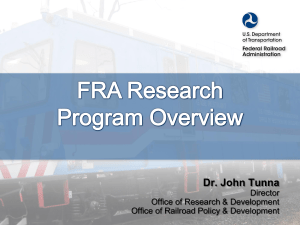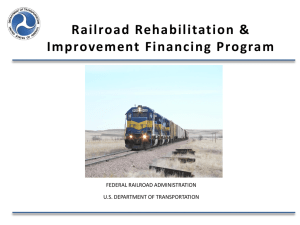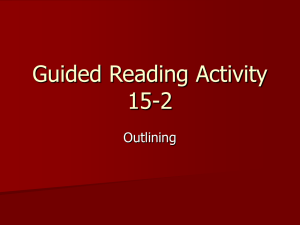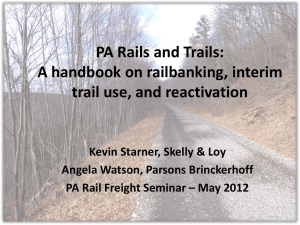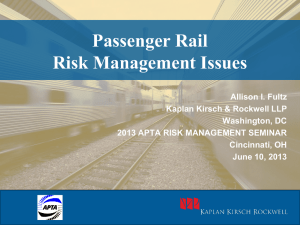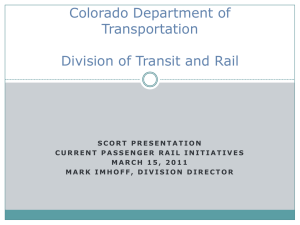TRB Gary Carr v1
advertisement
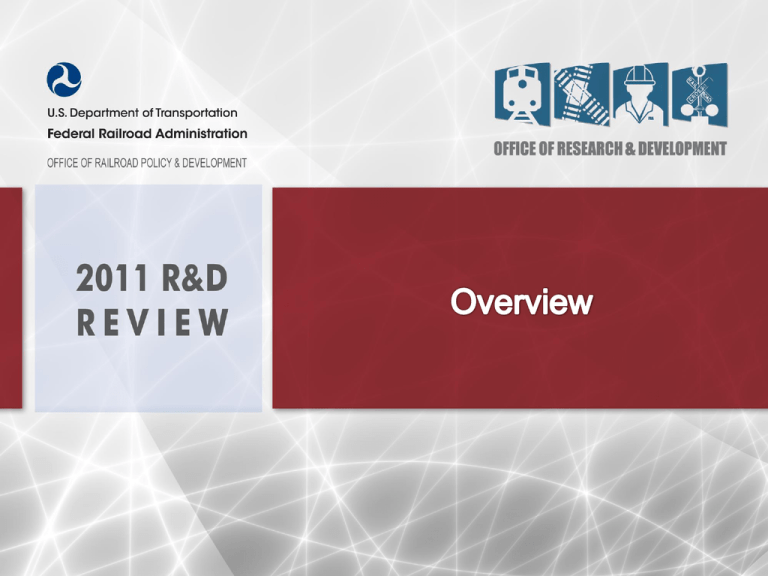
• • • • • • • • • Organization Core Research Areas Budgets Fit with D.O.T. strategic goals High Speed and Intercity Passenger rail Freight rail Facilities & Equipment Implementation Looking forward 2 Track Research Division • Track and Structures • Track / Train Interaction • Operations / Facilities ~150 projects typically $40M/year Equipment and Operating Practices • Rolling Stock And Components • Train occupant protection • Energy, Efficiency and Environment • Hazardous Materials • Human Factors Track & Structures Signals, Train Control and Communications Signals, Train Control & Comms • Signals and Train Control (Including PTC) • Grade Crossing • Communications Equipment & Operating Practices 3 60 50 $M 40 30 20 10 0 2001 2002 2003 2004 2005 2006 2007 2008 2009 2010 2011 2012 Core High-speed Maglev 2001 to 2011 - Enacted 2012 - Requested 4 • • • • • • Safety Livable Communities Economic Competitiveness Environmental Sustainability State of Good Repair High Speed/Improved Passenger Rail 5 • “Improve public health, safety, and security by reducing transportation-related fatalities and injuries” – D.O.T. • Scope of responsibility includes – – – – – – – Railroad employees Passengers on trains and in station areas Members of the public living near the railroad Members of the public using grade crossings and footbridges Trespassers Freight (all classes and short lines), intercity, commuter (not transit) Injuries as well as fatalities, health as well as safety 6 • Reportable train accidents Accidents per Million Train Miles 2.0 1.8 1.6 1.4 Equipment 1.2 Human Factors 1.0 Grade Crossing 0.8 Misc. (excl. GC) 0.6 Signal 0.4 Track 0.2 0.0 2004 2005 2006 2007 2008 2009 YEAR Source: FRA Safety Database 7 • Safety Risk Model – Indicates priorities for R&D – Separated into hazards and accident types – Separated into groups (passengers, workforce, public) – Allows calculation of safety metrics • Passenger – equivalent fatalities per billion passenger train kilometers • Workforce – equivalent fatalities per million worker hours • Risk exposure for a typical traveler or worker – Allows tracking of safety risk over time 8 • “Foster livable communities through place-based policies and investments that increase transportation choices and access to transportation services.” – D.O.T. • Some FRA R&D topics: – Improved grade crossings that safely accommodate pedestrians, bicycles, wheelchairs and baby strollers – Reduced noise and vibration from railroad operations – Improved access to railroad transportation for special needs populations and individuals with disabilities 9 • “Foster transportation policies and investments that serve the traveling public and freight movement, and bring lasting economic and social benefit to the Nation.” – D.O.T. • Some FRA R&D topics – Methods for increasing capacity – Development of domestic rail equipment manufacturing and testing facilities – Increasing the proficiency and retention of the workforce – New technology to improve competitiveness 10 • “Advance environmentally sustainable policies and investments that reduce carbon and other harmful emissions from transportation sources.” – D.O.T. • Some FRA projects – Alternative fuels – Improved efficiency of rail equipment 11 • “Ensure the U.S. proactively maintains its critical transportation infrastructure in a state of good repair.” – D.O.T. • Some FRA R&D topics – Rail corridor inspection and assessment equipment – Understanding the life cycle of railroad assets including defect initiation and growth rates – Challenges from high-speed and shared track corridors 12 Broad Agency Announcement priorities • Track & structures • Equipment • Autonomous and efficient inspection • 125 mph non-electric locomotive • Materials and construction • 125+ mph passenger equipment • Improved turnout performance • Vehicle weight and unsprung mass reduction • Corridor hardening • Modeling and simulation software • Train control • Grade crossing protection • Capacity improvements • Interoperable wireless communications • Positive Train Control (PTC) integration and enhancements • High-speed truck – passenger and freight • Train occupant protection • Human factors • Interface with controls and displays • Cab environment • Employee training for new technology and operations 13 Supplier contacts Concept papers submitted Concept papers accepted Proposals submitted Proposals accepted Awards 100+ 62 30 24 21 15 HSR R&D Account BAA and other Awards Committed (PRs) Next 6 Projects Projected Account Balance $25.0M $8.23M $0.65M $4.64M $11.48M 14 Track Other • Grade crossing improvements or elimination • Alignment and super-elevation in curves • Spiral design • Track geometry standards and maintenance • Maintenance windows • Inspection requirements • Turnout design • Bridge transitions • Capacity • Faster freight trains • Corridor “hardening” – Separation – Fencing – Wayside detectors • Cost allocation • Aerodynamics – Tunnels – Track workers • Electrification • Platform clearances TTC DOTX-218 CTIL 16 • • • • • 52 square miles near Pueblo, CO ~50 miles of test track Max. testing speed – 165 mph Laboratories and workshops AAR/TTCI has been the Care, Custody and Control contractor since 1982 • Current contract extended to September 30, 2022 • Most recent FRA/TTCI Partnering Agreement signed March 2011 • Bring ideas ‒ • • • • • Problems, opportunities, technology - emails or phone calls Review our publications and suggest next steps Look for ways to improve on successes Participate in technology evaluation and demonstrations Support cost-safety benefit analysis Suggest innovative partnerships and financing to implementation 18 2011 2012 M FY2011 J D M J S D M J S D Obligate Appropriate FY2012 FY2013 S 2013 Plan Roll-Up Obligate Congress Reviews Appropriate Obligate 19 • New Concept Identification – Early stakeholder engagement • Assessment FRA – Analysis and test – Cost-safety benefit analysis • Demonstration – In partnership with stakeholders • Implementation – Industry and Government rule changes • Measure impact – Safety, financial, performance • Improve – Technology, processes, rules Stakeholders 20 21 Project Description: • Research and development with goal of developing an automated means of quantifying switch and special track work condition to FRA standards. • Initial investigations have concluded that a combination of laser and vision technologies has the best chance of success. • Near term development efforts to concentrate on adapting laser and vision technologies to address measurement requirements, data analysis and processing, and system performance testing. Railroad Impact: • High resolution, automated inspection system for switch and other special track work. • Improved safety through accurate, routine inspection for compliance with FRA standards • Possible integration into existing geometry measurement platforms and autonomous systems. • Leverages technology achievements in laser and vision that have seen widespread use in the industry. Point of Contact Information: FRA Task Monitor: Cameron Stuart Phone Number: (202) 493- 6384 Email: Cameron.Stuart@dot.gov Project Partner: TBD. 22 Project Description: • This project is currently in the fourth year of a five year study, led by an Industry Steering Committee, to: • Determine the prevalence of and underlying causal factors for rail-related suicides • Develop effective measures to reduce the incidence of suicide along railway rights of way (including crossings) • Establish pilot programs for testing countermeasures • Develop standard protocol for documenting suicides and provide baseline data for monitoring trends • Retrospective and prospective assessments of the prevalence of suicide has been completed and comprehensive psychological autopsy data collected from 60 suicide cases. A pilot program has been initiated to evaluate use of signs as suicide prevention strategy. Data analysis is ongoing and will inform the development of additional suicide countermeasure pilot programs. Railroad Impact: • Addresses National Strategy for Suicide Prevention (U.S. Surgeon General, 2001) to “Promote efforts to reduce access to lethal means and methods of self-harm.” • Suicide accounts for 30 – 50% of trespasser-related serious injuries/fatalities on railroads • In 2004, suicide was the leading cause of rail-related fatalities in Illinois, with 30 probable suicide deaths and 3 additional attempts involving trains in Chicago alone. Point of Contact Information: FRA Task Monitor: Michael Coplen Phone Number: (202) 493-6346 Email: michael.coplen@dot.gov 23 Project Description: • Conduct a pilot study evaluating education and outreach methods used to educate the public of the hazards of grade crossings (Operation Lifesaver, Inc.) • One recent study, involving analysis of the effectiveness of education and enforcement strategies in two communities in the state of Illinois (PEERS), revealed different effectiveness results that could be partly associated with the methods the two different communities used to reach out to their citizens. Point of Contact Information: Railroad Impact: • Provide effectiveness estimates for different education and outreach methods • Relevant to Strategic Plan Topic “Education and Public Awareness” and Sec. 201, 206, 207, and 208 of the RSIA of 2008. FRA Task Monitor: Leonard W. Allen III Phone Number: (202) 493-6329 Email: Leonard.Allen@dot.gov 24 Project Description: • Create and facilitate a Trespass Prevention Stakeholders User Group including all stakeholders within the West Palm Beach Florida geographical area. Conduct site visits. Develop plan for acquiring locomotive video information in line with South Florida Rapid Transit Administration (SFRTA). • Work with stakeholders in partnership to review the implementation of signs, barriers and education efforts. Evaluate potential benefits of the lessons learned from local activities. Develop strategies for further reduction of trespass events within the study area. • Evaluate additional strategies through before and after data collection efforts. Railroad Impact: • Reduce trespass fatalities within the rail networks in West Palm Beach, Florida. • Document results via research results and reports and support the development of a US Guidance document on Trespass Reduction Strategies. Point of Contact Information: • Demonstrate potential benefits, including documenting best practices and lessons learned through implementation and rigorous evaluations conducted within the study area. • Relevant to Strategic Plan Topic “Education and Public Awareness” and Sec. 201 and 208 of the RSIA of 2008. FRA Task Monitor: Leonard W. Allen III Phone Number: (202) 493-6329 Email: Leonard.Allen@dot.gov 25 Project Description: • Establish consensus on vehicle dynamics safety limits which define adverse vehicle responses and severe loading of track structure • Apply analysis tools and simulation programs to define largest amplitude of geometry signatures that would not exceed safety limits (focus only on high speed & high cant deficiency operations) • Develop effective inspection techniques to identify critical track geometry signatures so that track/vehicle system operates within established safety limits Railroad Impact: • Track Geometry has been identified as one of major causes of main line derailments in US (15% of Track Caused Derailments). Point of Contact Information: • Improve railroad safety via reduction of track geometry conditions that cause derailments Phone Number: (202) 493-6438 FRA Task Monitor: Ali Tajaddini E-Mail: Ali.Tajaddini@dot.gov • More economic, accessible, and enforceable standards • New standards for combined geometry Project Partner: VOLPE 26 Project Description: • Proposed task intends to develop advanced means to visualize the results of manual inspections of suspected internal rail flaws; • Initial phase of study would employ a technology survey to ascertain the state-of-the-art in inspection technology; • Efforts will then focus on the use of signal processing practices used in other fields, such as tomography, or alternative approaches, to process data collected with the final goal of creating a user interface that displays a 3-D image of the rail defect being interrogated. Images Courtesy of Olympus NDT • Performs rapid sizing, type and location of rail flaws in the field. Railroad Impact: • Following the identification of a potential internal rail defect by an inspection vehicle, detailed inspections of suspect areas are conducted to confirm the presence of the defect prior to the removal of the affected area; • Follow-up inspections are often conducted with portable ultrasonic devices that require a significant amount of experience to properly operate; • This proposed task focuses on the development of instrumentation that yield easily interpreted results that could eventually lead to automated detection and imaging of internal rail flaws. Point of Contact Information: FRA Task Monitor: Leith Al-Nazer Phone Number: (202)493-6128 E-Mail: leith.al-nazer@dot.gov Project Partner: ENSCO Inc. 27 Large-scale test of NT/buckling @ UCSD Powell Labs Excitation at 275kHz: actuator PZT1 , sensor PZT4 0.075 /A2 Ultrasonic measurement =A 2 1 0.07 Buckling test of steel I-beam (exp.) 0.065 0.06 0.055 70 feet 0.05 NEUTRAL TEMPERATURE 0.045 0.04 INCIPIENT BUCKLING 0.035 0.03 0 5 10 15 20 25 30 Load [kips] Project Description: • Develop a new system for monitoring stress levels (NT) and incipient buckling in CWR by using mid- and high-frequency wave features that are little affected by rail supports. • Phase I preliminary studies (numerical FEA and experimental) showed sensitivity of certain linear and nonlinear wave features to stress levels in steel beams and rails. • In Phase II a unique large-scale testbed of CWR (70-ft long) has been constructed at the world-renowned UCSD Powell Structural Laboratories for conducting a series of heating tests in a controlled environment. • Based on the results of the large-scale laboratory tests, a prototype will be designed, assembled, and tested to determine NT & Incipient Buckling detection in CWR in motion or in a stationary manner. Railroad Impact: • Knowledge of NT in CWR is critical to avoid breakage in cold weather and buckling/instability in hot weather. Rail buckling was responsible for 48 derailments and ~$13M in direct costs during 2006 alone in U.S. • Methods to determine rail NT today either require unfastening of ~100’s feet of rail or are very sensitive to rail fastening/support conditions (e.g. D’Stresen technique too sensitive to tie-to-tie variations). • Railroads would benefit from a system able to measure rail stress and imminent buckling of CWR that can be operated in motion or in a stationary manner. Point of Contact Information: FRA Project Manager: Mahmood Fateh Phone: (202) 493- 6361 E-Mail: mahmood.fateh@dot.gov Project Partner: University of California, San Diego, Volpe and BNSF PI: Dr. Lanza di Scalea 28 Project Description: • Research and development program to adapt service-proven track geometry measurement technology to autonomous operation. Objectives: • Reduce capital and operating costs of geometry inspection systems • Provide routine and frequent data for safety assurance activities and track degradation analysis • Pilot system currently in service and performing well. Technology refinements currently in development to permit 90 day maintenance interval, improve automatic geo-location performance, and to perform automatic track degradation and reporting functions. Railroad Impact: • Continuous, un-manned geometry data collection provides critical track data in real-time wherever the system(s) are deployed. • No impact on rail traffic operations. The system can be installed on normal revenue railcars or locomotives and run in consist. • Track testing is automatically scheduled based on normal operation of the vehicle. • ATGMS provides a reduction in complexity, size and cost of traditional geometry systems without compromising performance. • Second system is currently in development for deployment on Amtrak NE Corridor. Point of Contact Information: FRA Task Monitor: Cameron Stuart Phone Number: (202) 493- 6384 Email: Cameron.Stuart@dot.gov Project Partner: ENSCO Inc. 29 Project Description: • The objective of this project is to design a system that will provide autonomous real-time measurements of track modulus from a moving railcar operating in revenue service (like no existing system). • Continuous modulus for large sections of track. • Currently working on commercial implementation and thresholds . Railroad Impact: • Significant support from both UPRR & BNSF • Validation test had significant support from UPRR (20-30 UPRR personnel and work train for 3 days) • BNSF & UPRR have committed to significant testing in 2010 (at least 2 tests with UPRR and 4 with BNSF on coal lines) • Conducted bridge study on UPRR investigating pads to reduce vertical track stiffness on bridges • Has tested over 10,000 miles of BNSF & UPRR coal lines in 200910 Point of Contact Information: FRA Task Monitor: Mahmood Fateh Phone Number: (202) 493- 6361 E-Mail: Mahmood.Fateh@dot.gov Project Partner: University of Nebraksa, Lincoln (UNL)- , BNSF, UPRR, OPPD, PI: Dr. Shane Farritor 30 Project Description: • To support FRA’s continuing research program to provide a technical and empirical basis for rule-making on enhanced and alternative performance standards for tank cars. This includes a review of new and innovative designs that are developed by the industry and other countries as well as full scale testing Protective panel added to tank car for side impact testing Point of Contact Information: Railroad Impact: • Evaluate crashworthiness performance of tank cars used in the transportation of Toxic by Inhalation materials (TIH) • Evaluate a new design protective panel to increase the crashworthiness of the tank car • Improve tank car design in order to improve hazardous materials transportation safety. FRA Task Monitor: Francisco González, III Phone Number: (202)493-6076 E-Mail: francisco.gonzalez@dot.gov Project Partner: TTCI (S Anankitpaiboon) 31 Project Description: • This project will develop a tailored, interactive, multi-media, web-based education program geared towards providing train crews and other railroad employees with: • Scientifically-valid information on the importance of sleep, • A customizable tool to assess personal risk for sleep disorders, and • Proven, practical strategies for improving sleep health. Railroad Impact: • Fatigue in the Transportation Industry is a pressing problem that has been singled out by the NTSB as a high priority for education and research since 1990. • The major underlying cause of fatigue-related rail accidents is sleepiness. An educational website for railroaders focusing on the causes of sleepiness and mitigation strategies under an operator’s control should reduce sleepiness and fatigue-related accidents. • The planned website can be used by individual railroad employees and as an education component of a railroad carrier’s fatigue management plan, as required by the Rail Safety Improvement Act of 2008. Point of Contact Information: FRA Project Manager: Michael Coplen Phone Number: (202) 493-6346 Email: michael.coplen@dot.gov 32 Project Description: • Develop a safety-critical, wireless, handheld device used by the employee-in-charge (EIC) of roadway workers to communicate with a CBTC system to: • Request and release work zones • Control entry and speed restrictions of trains allowed into the work zones Phase 3 Objectives: EIC PRT Current Functionality – Build 1 • Integration and testing with BNSF’s PTC system (ETMS). • Modifying current EIC PRT prototype to comply with operating rules/procedures, desired user interface characteristics, and the ETMS environment • Verify the EIC PRT meets safety requirements • Provide documentation to support interoperability • Perform all stages of testing required • Provide necessary input to the product safety plan • Accept and Display Maintenance of Way Protection (MWP) • Accept and Display Requests to Enter MWP • Transmit EIC Instructions to Locomotive Point of Contact Information: Benefit: Phone Number: (202)493-6362 • OBC enforcement and thereby protection is maintained through MWP with EIC specified movement parameters • Mitigates EIC working outside of MWP protected time • Prevents instructions to the locomotive by 3rd party (spoofing) through the EIC PRT communications interface. FRA Task Monitor: Jared Withers E-Mail: Jared.Withers@dot.gov Project Partner: TTCI (Thom Nast) 33 Project Description: • To develop a next generation communication network to support PTC/business applications • To assist in the migration to narrow banding of 160 MHz radios-integrate voice and data • To require robustness and throughput for railroad safety critical applications • To establish 220 MHz communication standards and protocols to support interoperability Railroad Impact: Point of Contact Information: • • • • FRA Project Manager: Jared Withers An integrated digital communication network Adoption of narrow-banding 160 MHz insures interoperability Upgraded communication network in compliance with FCC ruling Supporting train control, existing digital applications and foreseeable expansions Phone Number: (202) 493- 6362 Email: Jared.Withers@dot.gov 34 PTC Architecture – 220 MHz Comm Links Project Description: • Upgrade communications & testing capabilities of PTC Test Bed at TTC to support field testing of ITC-Compliant PTC 220 MHz radios. • Provide equipment for field testing 220 MHz radios • ITC-Compliant WIUs & radios for 10 WIU reporting locations, including 4 remotely controlled switches • 2 ITC-compliant base stations to support hand-off testing • 2 V/ETMS-equipped locomotives • Wabtec TMDS CAD system & ETMS BOS • Install required equipment • Integrate, test, and commission upgrade equipment • Perform check-out of enhanced Test Bed comms capabilities • Ensure upgrades support potential for future Test Bed expansions to provide test environments for full blown deployment testing with the communications density of a major metropolitan area Railroad Impact: • To meet PTC communications demands, the Industry has purchased 220 MHz frequency and is specifying a new PTC 220 MHz data radio. Communications among all PTC system elements will be via the 220 MHz network using these new radios. • A venue for field testing of PTC communications using the new radios will be needed in 2011 • Full implementation of PTC is contingent upon successful testing of ITC-Compliant 220 MHz radios Point of Contact Information: FRA Project Manager: Jared Withers Phone Number: (202) 493- 6362 Email: Jared.Withers@dot.gov Project Partner: TTCI (Richard Morgan) 35 Project Description: • Development of a simulation model to replicate a rail line operation with a specific train control method. • To simulate the dispatchers’ decision on prevention of deadlock, meet and pass planning and preset train priorities. • To generate metrics of risk exposures to interface with risk assessment. • To provide capacity/rail performance output.. Railroad Impact: • Improve on risk assessment and risk mitigation analysis. • Expedient preparation of Product Safety Plan of new train control system. • Optimize railroad line usage by safely increasing capacity with minimal investment. • Promote wider deployment of Positive Train Control technology. • Provide preliminary cost estimates of adding passenger rail service to freight rail lines. Point of Contact Information: FRA Project Manager: Karen McClure Phone Number: (202) 493- 6417 Email: Karen.McClure@dot.gov 36
